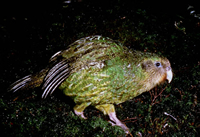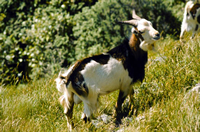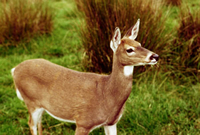Meet the hervbivores
 |
 |
 |
| Kākāpo | Goat | White-tailed deer |
Although birds in New Zealand did not reach the huge body proportions of mammals on other continents, they were still the largest herbivores within their ecosystems, and therefore played vital ecological roles. At least 50% of the bird species in New Zealand prior to the arrival of humans consumed plant material to some extent, yet only a few of these were exclusively herbivores. Moa were the largest, and technically the only ones that could be referred to as ‘megafauna’; however, our study will include a range of extinct and still living birds as outlined below. We also show the large mammalian herbivores currently affecting New Zealand’s indigenous vegetation communities.
Moa
Order: Dinornithiformes
- Upland moa (Megalapteryx didinus): Extinct. Occurred on the South Island. A short, slender-bodied moa with large claws and feathered ankles, adapted for living in steep, rocky and subalpine habitats. Image »
- Giant moa (Dinornis robustus on the South Island; D. novaezealandiae on the North Island): Extinct. These moa species had extreme size variation between sexes, the females being the tallest moa and up to 280% heavier than males. The giant moa occurred throughout a wide range of habitat types and altitudinal zones. Image »
- Eastern moa (Emeus crassus): Extinct. The eastern moa occurred east of the Southern Alps during the Holocene, predominantly in flat lowland basins and shrubland near coastal sites. Image »
- Stout-legged moa (Euryapteryx curtus): Extinct. Currently there are two species of moa in the genus Euryapteryx: the stout-legged moa (E. gravis) and coastal moa (E. curtus), which are being combined into a single clinal species on the basis of DNA analyses. As with eastern moa, the stout-legged moa was found east of the Southern Alps on the South Island, but extended further into the hill country. Image »
- Little bush moa (Anomalopteryx didiformis): Extinct. From the distribution of its bones, the little bush moa appears to be the only moa species that was adapted solely for living in closed-canopy forests. Currently there is no direct evidence for what this species might have eaten. Image »
- Heavy-footed moa (Pachyornis elephantopus): Extinct. The heavy-footed moa was a bird of open shrubland habitats, and occurred predominantly east of the Southern Alps during the Holocene. Large individuals of this species occurred during the last glacial maximum, and were probably among the heaviest of moa, weighing over 200 kg. Image »
- Crested moa (Pachyornis australis): Extinct. Perhaps the most poorly known of the moa species due to the relative rarity of its bones. It occurred most frequently in subalpine grasslands and shrublands along the Southern Alps. Image »
- Mantell’s moa (Pachyornis geranoides): Extinct. A small species of moa that occurred mostly in lowland and coastal habitats on the North Island. Image »
Geese and waterfowl
Family: Anatidae
- Giant flightless geese (Cnemiornis calcitrans on the South Island; C. gracilis on the North Island): Extinct. These geese weighed up to 18 kg (15 kg on North Island) and inhabited open grasslands, shrublands and riparian margins throughout New Zealand. Image »
- Finsch’s duck (Chenonetta finschi): Extinct. Formerly one of the most common and widespread ducks across New Zealand, it probably inhabited a range of terrestrial habitat types from riparian margins to shrubland and ephemeral gaps within podocarp forest. Skeletal evidence suggests it may have been flightless. Image »
- Paradise shelduck (Tadorna variegata): Still occurs throughout New Zealand, most commonly on grasslands (both natural and agricultural). Image »
Rails
Family: Rallidae
- Takahē (Porphyrio hochstetteri on the South Island; P. mantelli on the North Island): Just a small number of South Island takahē remain. Image » A few North Island takahē, or ‘moho’ may have survived into the 19th century although succumbed to extinction shortly thereafter. Image » Today, South Island takahē in the Fiordland Mountains feed mainly on the nutritious tillers of subalpine tussock grasses during summer, and roots of forest ferns during winter. Grass seeds are also eaten when available, and chicks eat insects.
- New Zealand coot (Fulica prisca): Extinct. A terrestrial or riparian herbivore that occurred across New Zealand, it appears to have been hunted to extinction by early Polynesian settlers. Image »
- Hodgen’s rail (Gallinula hodgenorum): Extinct. Occurred throughout New Zealand in riparian and mosaic shrubland habitats. Although it is included here as dominantly a herbivore, its diet probably also included some invertebrate material. Image »
Parrots
Family: Psittaciformes
- Kākāpo (Strigops habroptilus): A large, flightless, nocturnal parrot, the k ākāpo is effectively extinct in the wild, the only remaining birds (<100) being in managed populations on offshore islands. In prehuman times, kakapo occurred in forests and shrublands throughout New Zealand, and had a widely varied diet including fruit, seeds, leaves, twigs, roots, and bark.
Introduced ungulates
- Deer: Seven different deer species are wild in New Zealand. Most are restricted in distribution, but red deer (Cervus elaphus scoticus) and white-tailed deer (Odocoileus virginianus borealis) are quite widespread. Deer were first liberated and established in the late 19th century. Populations, especially of red deer, continued to rise until they began to devastate native high-country grasslands. A period of intense hunting and live-capture during the 1960s-70s helped reduce populations.
- Goat (Capra hircus): Goats were first released by Captain James Cook in 1773, and soon after more were liberated around the country by sealers and whalers. Goats occur mainly in forests and hill-country scrubland.
